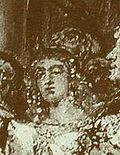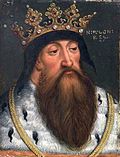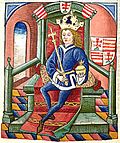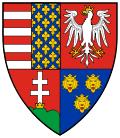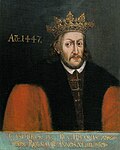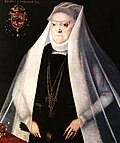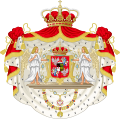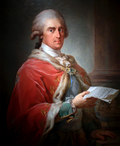| Monarchy of Poland | |
|---|---|
 | |
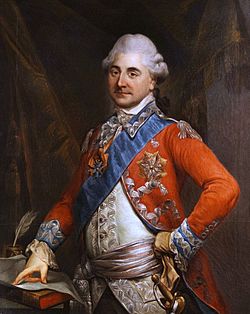 | |
| Details | |
| Style |
|
| First monarch |
|
| Last monarch | Stanislaus II Augustus |
| Formation | c. 960 (Duchy of Poland) |
| Abolition | 25 November 1795 |
| Residence | |
| Appointer | Hereditary [a] Elective |
| Pretenders |
|
Poland was ruled at various times either by dukes and princes (10th to 14th centuries) or by kings (11th to 18th centuries). During the latter period, a tradition of free election of monarchs made it a uniquely electable position in Europe (16th to 18th centuries).
Contents
- Legendary
- Debatable rulers
- House of Piast
- Fragmentation of Poland (1138–1320)
- Attempt at restoration (1295–1296)
- Přemyslid House
- House of Piast (restored)
- House of Anjou
- House of Jagiellon
- Polish–Lithuanian Commonwealth, 1569–1795
- Duchy of Warsaw, 1807–1815
- Poland from 1815 to 1918
- Family tree of the rulers of Poland
- Pretenders to the Polish throne
- Modern
- Not recognized royal elections
- See also
- Notes
- References
- Bibliography
- External links
The first Polish ruler whose existence is not debatable was Duke Mieszko I, who adopted Christianity under the authority of Rome in the year 966. He was succeeded by his son, Bolesław I the Brave, who greatly expanded the boundaries of the Polish state and ruled as the first king in 1025. The following centuries gave rise to the mighty Piast dynasty, consisting of both kings such as Mieszko II Lambert, Przemysł II or Władysław I the Elbow-high and dukes like Bolesław III Wrymouth. The dynasty's rule over Poland ceased with the death of Casimir III the Great in 1370. In the same year, the Capetian House of Anjou became the ruling house with Louis I as king of both Poland and Hungary. His daughter, Jadwiga, later married Jogaila, the pagan Grand Duke of Lithuania, who in 1386 was baptized and crowned as Władysław II Jagiełło, thus creating the Jagiellonian dynasty and a personal union between Poland and Lithuania.
During the reign of Casimir IV Jagiellon and Sigismund I the Old, culture flourished and cities developed. This era of progress, also known as the Polish Renaissance, continued until the Union of Lublin under Sigismund II Augustus, which unofficially marked the end of the Polish Golden Age. After the death of the last Jagiellonian king, the united Polish–Lithuanian Commonwealth became an elective monarchy with mostly foreigners elected as monarchs such as Henry III of France, who witnessed the introduction of the Golden Liberty system and Stephen Báthory, a capable military commander who strengthened the nation. The meaningful rule of the Vasa dynasty initially expanded the Commonwealth as the arts and crafts developed, as well as trade and commerce. King Sigismund III Vasa, a talented but somewhat despotic ruler, involved the country in many wars, which subsequently resulted in the successful capture of Moscow and the loss of Livonia to Sweden. His son, Władysław IV Vasa, fiercely defended the Commonwealth's borders and continued the policy of his father until his death, unlike John II Casimir whose tragic rule resulted in his abdication.
The election of John III Sobieski to the Polish throne proved to be beneficial for the Commonwealth. A brilliant military tactician, John III led the coalition forces to victory at Vienna in 1683 and he partially recaptured land from the Ottoman Empire. However, the years that followed were not as successful. [3] The long and ineffective rule of the Wettin dynasty (Augustus II the Strong and Augustus III) placed the Commonwealth under the influence of Saxony and the Russian Empire. Additional feuds with rebel nobility (szlachta) and most notably Stanislaus I Leszczyński and France diminished the influence of Poland–Lithuania in the region, which led to the partitions that occurred under King Stanislaus II Augustus, yet another enlightened, but ineffective monarch. The last true sovereign of Poland was Frederick Augustus I as Duke of Warsaw, who throughout his political career attempted to rehabilitate the Polish state.
Following the Napoleonic Wars, many sovereigns claimed the title of Polish king, duke or ruler, notably German (the King of Prussia was also the sovereign of the Grand Duchy of Posen 1815-1918), Russian (the Congress Kingdom of Poland was founded in 1815 with the widely unrecognized title of King of Poland to the Emperor of Russia until 1915) and Austrian emperors (the Emperor of Austria was sovereign of the Kingdom of Galicia and Lodomeria between 1772 and 1918, and the Grand Duchy of Kraków between 1846 and 1918). The new Kingdom of Poland was proclaimed as an independent state in 1916 with a Regency Council but the monarchy was abolished and a parliamentary republican authority was established when Poland was re-constituted as a sovereign state in 1918.

















